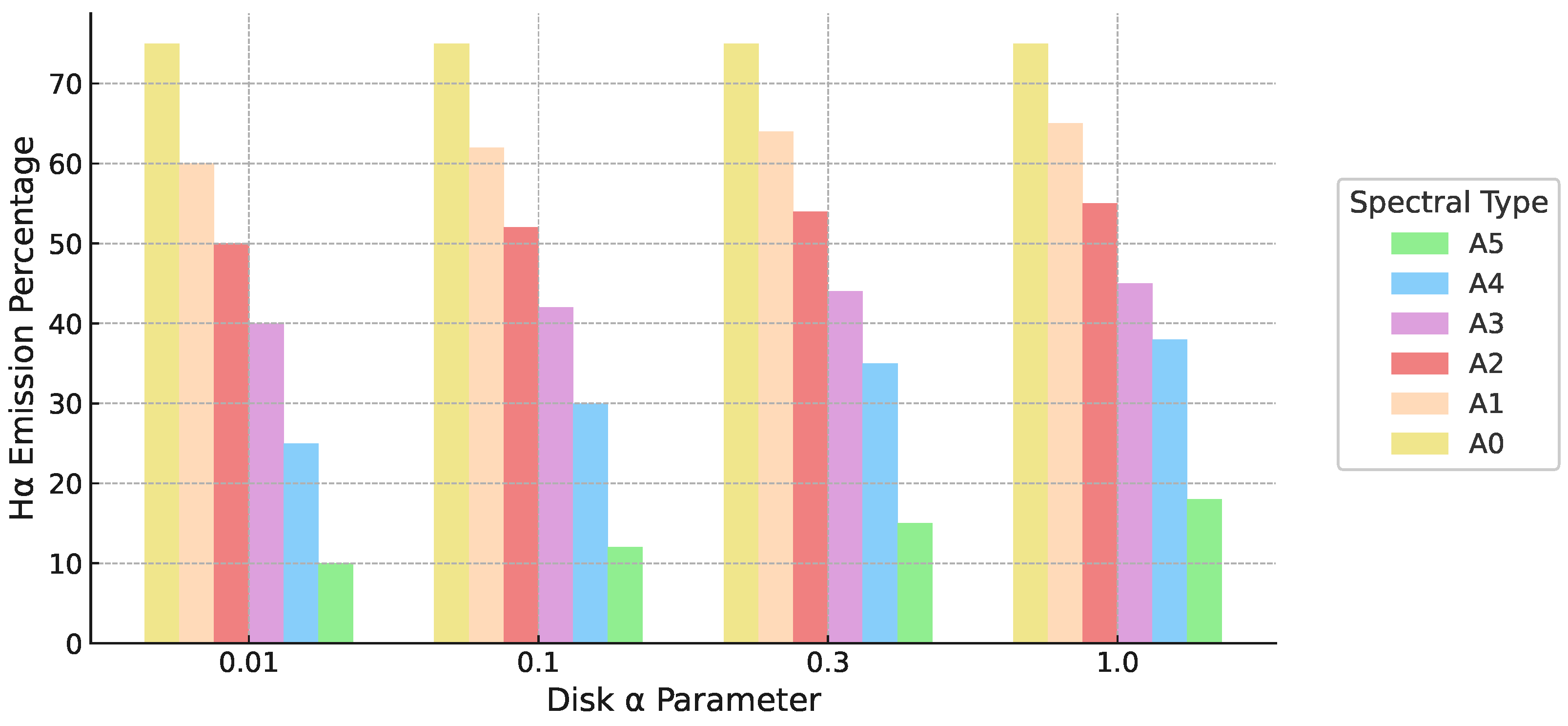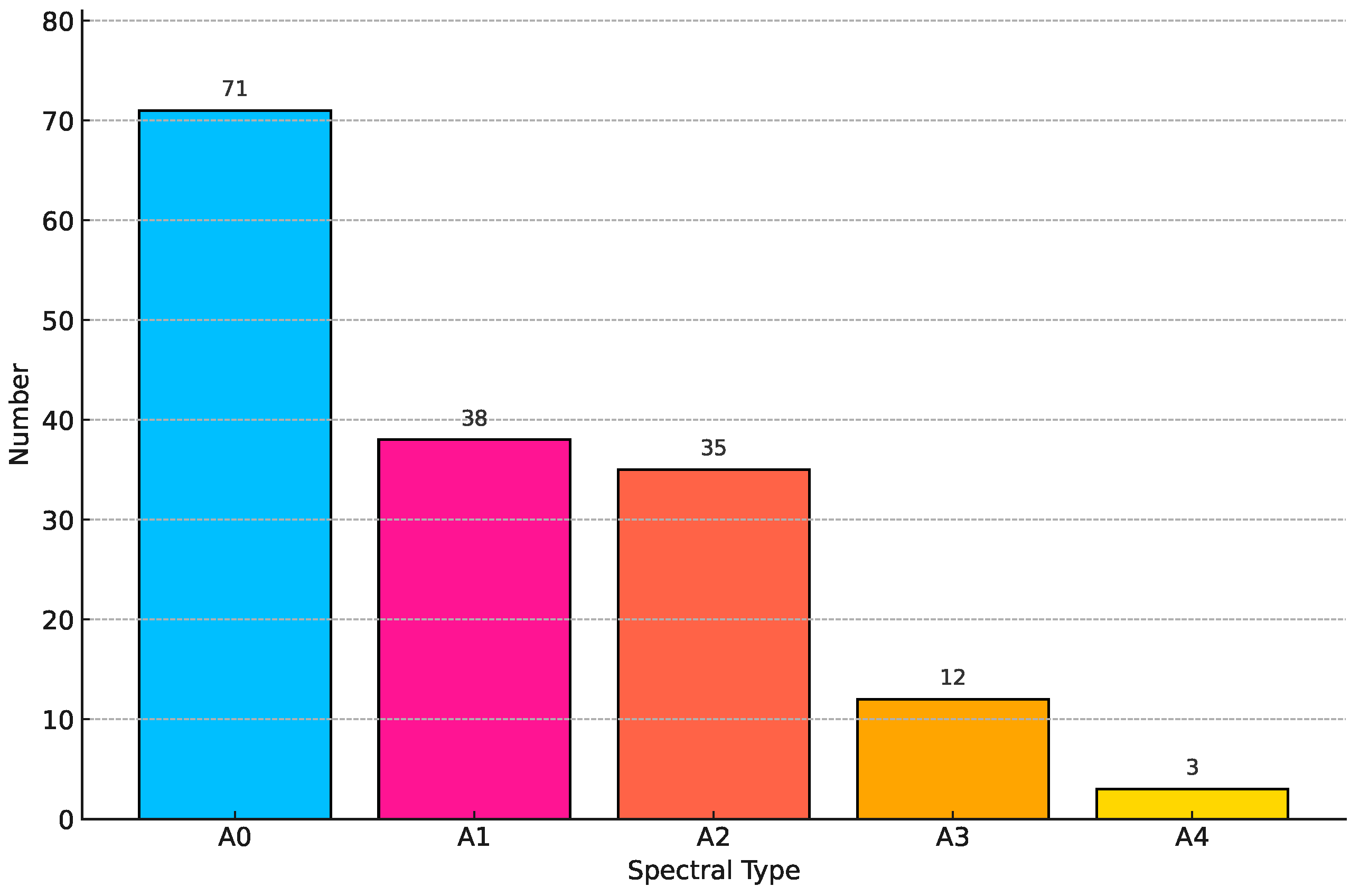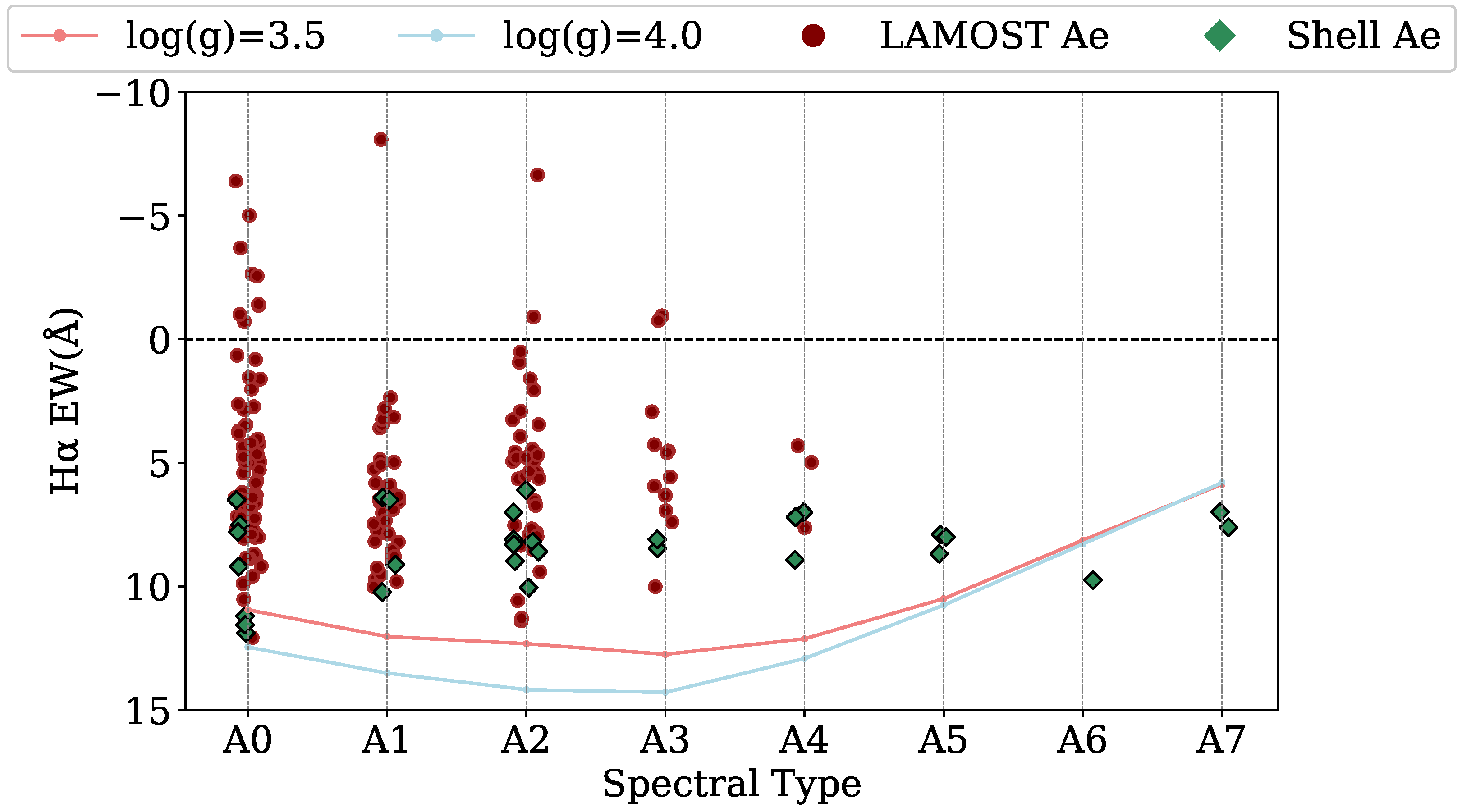The Effect of Viscosity on the Temperature of Ae Star Disks
Abstract
1. Introduction
2. Methods
Including Viscous Shear Heating in the Disk
3. Results
3.1. Modeling the H Emission
3.2. The Disk Temperatures
3.3. Observed CAe Stars
4. Discussion
- The contribution of shear heating to the predicted disk temperature and fraction of detectable H emission is negligible for early A-type stars (A0–A1). However, for cooler spectral subtypes, this effect becomes increasingly significant, with the viscosity parameter influencing the emission fraction (Figure 1). Higher values of also tend to predict disks with wide range of temperatures having detectable emission, indicating effective heating (Figure 2). This trend suggests that the parameter could be constrained using observed samples of CAe stars, particularly for later-type A stars.
- The models predict a sharp decline in the number of emission-line stars beyond spectral type A2, a trend that is also evident in observational data (Figure 3). This drop in the predicted number of emission stars is due to the cooler disk temperatures at later spectral types that dramatically reduce the excited state hydrogen level populations. However, for sufficiently high values of (≥0.3), shear heating raises the disk temperatures, and a greater fraction of emitters is expected even among cooler subtypes, such as A5. Notably, a well-characterized sample of CAe stars beyond spectral type A4 has not been identified.
Author Contributions
Funding
Data Availability Statement
Acknowledgments
Conflicts of Interest
References
- Struve, O. On the Origin of Bright Lines in Spectra of Stars of Class B. Astrophys. J. 1931, 73, 94. [Google Scholar] [CrossRef]
- Carciofi, A.C.; Bjorkman, J.E. Non-LTE Monte Carlo Radiative Transfer. I. The Thermal Properties of Keplerian Disks around Classical Be Stars. Astrophys. J. 2006, 639, 1081–1094. [Google Scholar] [CrossRef]
- Rivinius, T.; Carciofi, A.C.; Martayan, C. Classical Be stars. Rapidly rotating B stars with viscous Keplerian decretion disks. Astron. Astrophys. Rev. 2013, 21, 69. [Google Scholar] [CrossRef]
- Lee, U.; Osaki, Y.; Saio, H. Viscous excretion discs around Be stars. Mon. Not. R. Astron. Soc. 1991, 250, 432–437. [Google Scholar] [CrossRef]
- Carciofi, A.C. The circumstellar discs of Be stars. In Proceedings of the IAU Symposium; Neiner, C., Wade, G., Meynet, G., Peters, G., Eds.; Cambridge University Press: Cambridge, UK, 2011; Volume 272, p. 325. [Google Scholar]
- Haubois, X.; Carciofi, A.C.; Rivinius, T.; Okazaki, A.T.; Bjorkman, J.E. Dynamical Evolution of Viscous Disks around Be Stars. I. Photometry. Astrophys. J. 2012, 756, 156. [Google Scholar] [CrossRef]
- Rímulo, L.R.; Carciofi, A.C.; Vieira, R.G.; Rivinius, T.; Faes, D.M.; Figueiredo, A.L.; Bjorkman, J.E.; Georgy, C.; Ghoreyshi, M.R.; Soszyński, I. The life cycles of Be viscous decretion discs: Fundamental disc parameters of 54 SMC Be stars. Mon. Not. R. Astron. Soc. 2018, 476, 3555–3579. [Google Scholar] [CrossRef]
- Shakura, N.I.; Sunyaev, R.A. Black holes in binary systems. Observational appearance. Astron. Astrophys. 1973, 24, 337. [Google Scholar]
- Carciofi, A.C.; Bjorkman, J.E.; Otero, S.A.; Okazaki, A.T.; Štefl, S.; Rivinius, T.; Baade, D.; Haubois, X. The First Determination of the Viscosity Parameter in the Circumstellar Disk of a Be Star. Astrophys. J. Lett. 2012, 744, L15. [Google Scholar] [CrossRef]
- Clark, J.S.; Tarasov, A.E.; Okazaki, A.T.; Roche, P.; Lyuty, V.M. Phase changes of the Be/X-ray binary X Persei. Astron. Astrophys. 2001, 380, 615–629. [Google Scholar] [CrossRef]
- Sigut, T.A.A.; Jones, C.E. The Thermal Structure of the Circumstellar Disk Surrounding the Classical Be Star γ Cassiopeiae. Astrophys. J. 2007, 668, 481–491. [Google Scholar] [CrossRef]
- Sigut, T.A.A. The Bedisk and Beray Circumstellar Disk Codes. In Workshop on Astrophysical Opacities; Astronomical Society of the Pacific Conference Series; Astronomical Society of the Pacific: San Francisco, CA, USA, 2018; Volume 515, p. 213. [Google Scholar]
- Grundstrom, E.D.; Gies, D.R. Estimating Be Star Disk Radii using Hα Emission Equivalent Widths. Astrophys. J. Lett. 2006, 651, L53–L56. [Google Scholar] [CrossRef]
- Gies, D.R.; Bagnuolo, W.G., Jr.; Baines, E.K.; ten Brummelaar, T.A.; Farrington, C.D.; Goldfinger, P.J.; Grundstrom, E.D.; Huang, W.; McAlister, H.A.; Mérand, A.; et al. CHARA Array K’-Band Measurements of the Angular Dimensions of Be Star Disks. Astrophys. J. 2007, 654, 527–543. [Google Scholar] [CrossRef]
- Stee, P.; Meilland, A.; Bendjoya, P.; Millour, F.; Smith, M.; Spang, A.; Duvert, G.; Hofmann, K.H.; Massi, F. Evidence of an asymmetrical Keplerian disk in the Brγ and He I emission lines around the Be star HD 110432. Astron. Astrophys. 2013, 550, A65. [Google Scholar] [CrossRef]
- Pringle, J.E. Accretion discs in astrophysics. Annu. Rev. Astron. Astrophys. 1981, 19, 137–162. [Google Scholar] [CrossRef]
- Cui, X.Q.; Zhao, Y.H.; Chu, Y.Q.; Li, G.P.; Li, Q.; Zhang, L.P.; Su, H.J.; Yao, Z.Q.; Wang, Y.N.; Xing, X.Z.; et al. The Large Sky Area Multi-Object Fiber Spectroscopic Telescope (LAMOST). Res. Astron. Astrophys. 2012, 12, 1197–1242. [Google Scholar] [CrossRef]
- Anusha, R.; Mathew, B.; Shridharan, B.; Arun, R.; Nidhi, S.; Banerjee, G.; Kartha, S.S.; Paul, K.T.; Bhattacharyya, S. Identification of new classical Ae stars in the Galaxy using LAMOST DR5. Mon. Not. R. Astron. Soc. 2021, 501, 5927–5937. [Google Scholar] [CrossRef]
- Kurucz, R.L. New Lines, New Models, New Colors. In Precision Photometry: Astrophysics of the Galaxy; Philip, A.G.D., Upgren, A.R., Janes, K.A., Eds.; L. Davis Press: New York, NY, USA, 1991; p. 27. [Google Scholar]
- Jaschek, C.; Andrillat, Y. AE and A type shell stars. Astron. Astrophys. Suppl. Ser. 1998, 130, 507–512. [Google Scholar] [CrossRef]
- Hümmerich, S.; Paunzen, E.; Bernhard, K. Searching for shell stars in LAMOST DR4 by probing the Fe 42 multiplet lines. Mon. Not. R. Astron. Soc. 2022, 517, 4229–4246. [Google Scholar] [CrossRef]




| Spectral | Mass | Radius | |
|---|---|---|---|
| Type | |||
| A0 | 9600 | 2.46 | 2.60 |
| A1 | 9200 | 2.31 | 2.52 |
| A2 | 9000 | 2.21 | 2.46 |
| A3 | 8600 | 2.15 | 2.43 |
| A4 | 8400 | 2.10 | 2.40 |
| A5 | 8200 | 2.04 | 2.37 |
Disclaimer/Publisher’s Note: The statements, opinions and data contained in all publications are solely those of the individual author(s) and contributor(s) and not of MDPI and/or the editor(s). MDPI and/or the editor(s) disclaim responsibility for any injury to people or property resulting from any ideas, methods, instructions or products referred to in the content. |
© 2025 by the authors. Licensee MDPI, Basel, Switzerland. This article is an open access article distributed under the terms and conditions of the Creative Commons Attribution (CC BY) license (https://creativecommons.org/licenses/by/4.0/).
Share and Cite
Anusha, R.; Sigut, T.A.A. The Effect of Viscosity on the Temperature of Ae Star Disks. Galaxies 2025, 13, 54. https://doi.org/10.3390/galaxies13030054
Anusha R, Sigut TAA. The Effect of Viscosity on the Temperature of Ae Star Disks. Galaxies. 2025; 13(3):54. https://doi.org/10.3390/galaxies13030054
Chicago/Turabian StyleAnusha, R., and T. A. A. Sigut. 2025. "The Effect of Viscosity on the Temperature of Ae Star Disks" Galaxies 13, no. 3: 54. https://doi.org/10.3390/galaxies13030054
APA StyleAnusha, R., & Sigut, T. A. A. (2025). The Effect of Viscosity on the Temperature of Ae Star Disks. Galaxies, 13(3), 54. https://doi.org/10.3390/galaxies13030054







